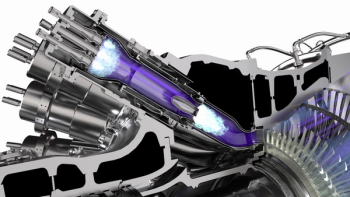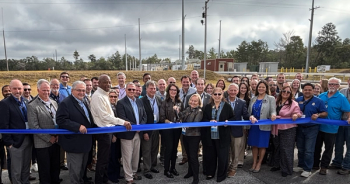
The Effect of Bearings on GT Rotordynamics
Aeroderivative gas turbines (GT) generally use rolling-element bearings. These machines should be modeled as rotor assemblies supported by nonlinear bearings and installed on flexible bearing supports. Dynamic behavior is nonlinear, since bearing stiffness varies with speed, applied preload, and transmitted loads (due to unbalance). The rollingelement bearing should be modeled in five degrees of freedom and the nonlinear stiffness characteristics of the bearings should be completely described as functions of combined loads and speed.
The nonlinear model is essential for any turbomachinery that uses rolling-element bearings. In one aeroderivative GT case study, detailed comparison showed great differences between an accurate nonlinear model and a model based on linear assumptions. In this example, the discrepancies of the first and the second critical speeds of the two models were 12% and 9%, respectively. In other words, linear assumptions can easily result in missed resonances, operational problems and even serious damage.
Heavy industrial turbines
Critical issues related to the journal bearings of heavy industrial gas turbines are proper bearing design, sufficient loading capacity of bearings, proper lubrication system (sufficient flow of the clean, cooled lubrication oil) and a properly selected jacking oil system.
The jacking oil concept requires special considerations. The contaminated lubrication oil statistically could be the root-cause for many failures and operational problems in industrial gas turbines.
Generally, a robust design, a highstrength structure and a high-grade Babbitt material should be used. Different parameters such as the oil-film details, the maximum pressure and the minimum clearance should carefully be evaluated against the speed. The lubrication flow, pressure and temperature require proper monitoring. Bearing metal temperatures are also important for monitoring and operation.
Sometimes, high vibration, excessive dynamic forces, an operator mistake or another operational malfunction may result in broken lubrication oil piping connections. (These could lead to immediate bearing damage). Usually the lubrication oil piping system is overlooked. High reliability and robust design are required for lubrication oil piping. A balance between distance of supports, piping flexibility, and operational requirements should be achieved.
“The nonlinear stiffness characteristics of rollingelement bearings influence the dynamic behavior of aeroderivative GTs.”
Insufficient jacking oil flow has been the cause of damages on many journal bearings. An adequate jacking oil pressure level can maintain a minimum oil-film thickness at low rotational speeds and could limit the peak pressure loading on the Babbitt of the bearings.
As a rough indication, for an estimate on the jacking oil flow, the minimum oil-film thickness could be above 50-60 micron at below 200 rpm and above 30-45 micron at 350-500 rpm. For higher speeds, a minimum film thickness of about 20-30 micron has to be maintained to ensure safe operation of a journal bearing without scratching or even wiping the Babbitt. Insufficient jacking oil flow during startup or shutdown could cause serious bearing damages.
Journal bearings of industrial gas turbines can present nonlinear behavior, but offer less nonlinearity compared to the rolling-element bearings in aeroderivatives. Many simulations have demonstrated that linear rotordynamics cannot account for proper vibration prediction during all operation modes.
For example, in a relatively high unbalance, as can occur during operation, such as marginal unbalance close to alarm or trip levels, the linear assumptions are insufficient and a proper nonlinear model is required for accurate simulations.
The strongest influence on discrepancies between simulation results and experimental measurements are from variations in effective static and dynamic loads on each bearing due to non-perfect rotor train alignment from effectively non-parallel axes of rotor and bearing liner.
A detailed model considering all these effects (depending on each bearing type and model) is required. Even a detailed model would show some discrepancies because of tolerances, and, more importantly, due to varying conditions in interfaces. Nonlinearities in interfaces (friction and looseness) of bearing systems and bearing support structures (down to the foundation) can change the system stiffness according to effective loads and pre-loads (for example, with the state of alignment).
Properly designed high-load-capacity journal bearings could work reliably if sufficient care is taken with all auxiliary equipment. Speed transient conditions are critical. Sufficient jacking oil should be provided to ensure a minimum oil film thickness, ascertaining that the local film pressure does not exceed the limits for the Babbitt material (on the bearings), and no rubbing can occur. Clean, cooled and sufficient lubrication oil flow is necessary. An accurate nonlinear model is needed to assess correctly gas turbine rotordynamics.
Newsletter
Power your knowledge with the latest in turbine technology, engineering advances, and energy solutions—subscribe to Turbomachinery International today.




